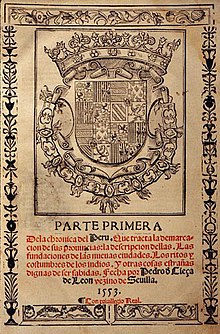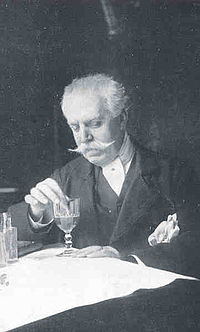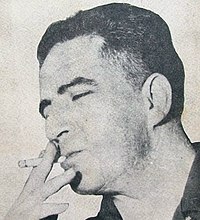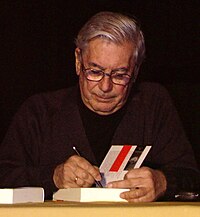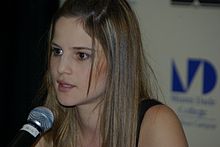Peruvian literature
The Peruvian literature , the literature of Peru (mainly) in the Spanish language, and thus a part of the Hispanic literature. It is one of the literatures of Latin America, of which only a few, but especially the 2010 Nobel Prize winner Mario Vargas Llosa , became known in Germany. The literature of Peru also includes the Spanish-language literature of the Spanish viceroyalty kingdoms of New Castile and Peru , but without the literatures of the areas that were separated from the viceroyalty kingdoms until Peru's independence, such as Chile , Colombia , Bolivia and Ecuador .
Lima was the intellectual center of all of Spanish-speaking South America for a long time during the colonial period. In the early colonial period, works in the most important language of the indigenous population, Quechua , were also published. Like the Aymara , it experienced a renaissance in the 20th century, but especially since the turn of the millennium. Since Quechua literature is produced in several dialects in other Andean countries as well, it is dealt with here only in passing, but in a separate article.
The time of the viceroyalty
In the non- written Inca empire there were chroniclers and epic singers who passed on their texts orally. In addition, there were many lyrical genres such as hymns, love and dance songs, erotic songs and burlesques, as well as forms of theater, which only existed since the 17th and 18th centuries. Century were recorded under noticeable Spanish influence. The Inca heroic epics, such as the one about the Ayar brothers, have only been handed down in rudimentary form.
In the early phase after the Spanish Conquista , apologetic chronicles were written to justify the conquest; later there was a certain understanding of the high culture of the Inca, for example in the monumental Crónica del Perú (1553) by Pedro Cieza de León (1518 (?) - 1554), who carefully recorded the process of colonization and Christianization of the country. The Inca prince Titu Cusi Yupanqui , ruler of a small remaining empire of his people until his death, wrote a chronicle of the Spanish conquest in 1570 in which he complained to King Philip I about the conquest of the empire of his ancestors by the Spaniards.
Since the end of the 16th century, however, the purpose of conversion was in the foreground of the reports, combined with the criticism of the “barbaric” customs of the Inca (human sacrifice, dynastic incest ). A largely mestizo clergy transformed Quechua texts for the purpose of moral instruction and proselytizing into the religious; new plays in this language were also created. One of the oldest works of Peruvian literature, like Quechua literature as a whole, is Apu Ollantay , a drama whose oral tradition dates back to the Inca times and which was written in the Quechua language during the colonial period.
An outstanding chronicler was Inca Garcilaso de la Vega , son of a Spanish conquistador and an Inca princess, who was able to speak Quechua but also proved to be a good stylist of the Spanish language. He went to Spain in 1560 and published La traducción de los tres Diálogos de Amor de León Hebreo in 1590 , an adaptation of the Dialoghi d'Amore by Leone Ebreo . La Florida del Inca appeared in 1592 and in 1609 the Comentarios reales (English: Royal Commentaries ), which can be considered an early expression of a cultural mestizaje . He used Spanish as well as oral indigenous sources and saw the Conquista as the completion of the cultural development successfully started by the Incas; these would have tamed the barbaric Indians of the pre-Inca period. The sequel Historia general del Perú appeared posthumously in 1617 , which deals extensively with the execution of the Inca king Atawallpa by Francisco Pizarro . For him, communication problems in particular seem to have led to an escalation, as a result of which Atawallpa, whom he also considers to be an illegitimate bastard, was killed. He sticks to his assessment that the past of the Incas, which he regards as the forerunner of the Spaniards, could enter into a future-oriented connection with the Christian faith of the Spaniards in the form of a new civilization. So he reports - knowing full well that many conquistadors like Pizarro were illiterate - about the cultural achievements of his maternal ancestors from medicine and mathematics to poetry and agricultural engineering. The representation earned the author high recognition; he is considered one of the earliest theorists and advocates of the Latin American cultural synthesis. The anecdotes at the end are also early examples of the literary use of the chronicles.
The Hispanic Indian Felipe Guaman Poma ( Waman Puma de Ayala ) lacked these educational requirements, who wrote his Nueva crónica y buen gobierno (1615, printed in 1936) from the perspective of the nobleman of a tribe subjugated by the Inca and at the same time from a Christian but anti-clerical perspective Composed of almost 1200 sheets and provided with illustrations by hand. The chronicle contains a lot of historical and ethnographic information, evidently supported by his own trips, and provides a good picture of the structure of colonial society. It ends with imploring appeals to the distant King Philip III: to put an end to the system of forced labor and oppression and recommends racial segregation as a remedy.
Lima, where a university - today's Universidad Nacional Mayor de San Marcos - was founded as early as 1551 , developed alongside Mexico City into the most important poetry center in the Spanish colonies at the end of the 16th century . A variety of literary activities arose both at the viceroy's court and in the religious orders. Peru already had its own printing company in 1582 (for comparison: Bogotá only in 1738). Here the literaryization of the chronicles reached a climax, especially in comparison to the undeveloped peripheral areas of the empire, from which mainly travel reports came. The Baroque Lima followed "unconditionally the gongoristischen style dictates." This phase produced mainly spiritual poems, such as those based on sermons and dramas by the clergyman Juan de Espinosa Medrano , who came from an indigenous family and who defended Gongorism to show that the colonies were not behind the motherland, although he overlooked that this could no longer claim a leadership function in Europe in poetological terms. His dramas were shaped by the influence of Calderón . In addition, there were gongoric epics, bucolic and religious poetry, Corpus Christi games and satires, the comprehension of which was made difficult by the cumbersome language.
While the importance of Quechua declined in the early 18th century, Creole literature developed that no longer consisted primarily of religious or ethnological texts and chronicles. As a precursor of Costumbrismo peruano Spanish model, that is a regionally oriented and customs reflecting literature can Pedro Peralta y Barnuevo apply (1664-1743). In his founding epic from Lima, published in 1732, French-rationalist (neoclassical) influences can already be seen. In Pedro de Peralta Barnuevo there are echoes of Corneille ; he also adapted works by Molière . The Limas theater, which was particularly sponsored by the regent after 1761, opened up even further to French influences. However, the Enlightenment in the remote Andean countries was more difficult than in Argentina, where Buenos Aires, with its close trade contacts to Europe, established itself as the intellectual center of the Enlightenment.
19th century
In 1821 the viceroy evacuated his capital Lima in front of the approaching troops of Simón Bolívar . Peru was hardly prepared for independence; its demarcation was only determined in bloody conflicts with the neighboring countries that dragged on into the 1880s.
An important representative of the Peruvian emancipation literature was Joaquín de Olmedo , the (co-) creator of the Bolívar cult, an early representative of early romantic poetry Mariano Melgar .
The local customs , the first manifestation of a Peruvian national literature, begins with the aristocratic opponents of independence José Joaquín de Larriva y Ruiz (1780-1832), who became popular through eulogies, satires, comedies and products. The playwright and satirist Felipe Pardo y Aliaga (1808–1868), who was also an opponent of Bolívar as a conservative and was temporarily in exile in Spain, continued, like Manuel Ascensio Segura, the costumbrist tradition with its criticism of the backwardness and inefficiency of the administration. Lima had long since lost its cultural lead over other Latin American regions because it had lived too long in the shadow of court culture. The country also stagnated economically due to the decline in mining and only experienced a brief boom due to the guano export from 1850-1880.
Ricardo Palma created in the 19th century with his popular Tradiciones a literary genre that is regarded as testimony to a liberal Creole middle class in the context of romantic historicism, a mixture of fiction and history that overcomes the costumbrist self-limitation to the immediate present, but in a traditional, even antiquated style remains arrested. The Argentina-born forerunner of the feminist movement Juana Manuela Gorriti is also counted among the Peruvian authors. She lived in Lima for a long time from the 1840s, where she published her first prose texts. Her stories contain autobiographical, romantic and fantastic elements.
Peruvian modernism began with his early poem Al amor by Manuel González Prada , which was published in the El Comercio newspaper in 1867 . González Prada, son of an aristocratic family from Lima, radical critic of the clergy and the continued Spanish influence in Latin America, excommunicated positivist and anarchist who lived in Europe for a long time, influenced numerous other Peruvian authors. This is especially true for Clorinda Matto de Turner , whose novels are also shaped by the Inca culture. Her work is considered the starting point of indigenist literature in Latin America, which focuses on the problems of the indigenous population. As a civil women's rights activist, she went into exile in Argentina in 1895. The work of the early feminist Mercedes Cabello de Carbonera was influenced by González Prada, positivism and European realism .
After the lost Saltpeter War and the ensuing ethnic unrest, there was a growing desire for a civil government that would recognize the social realities and end the division of the country between the coastal and mountainous populations. Positivism played a socially stabilizing role , the influence of which had been palpable throughout Latin America since 1880 and which was used to curb the influence of mysticism and religion. However, this anti-religious movement led to a devaluation of indigenous culture and the Quechua language. Costumbrismo was replaced by the orientation towards European models in France and England, until Hispanic America set literary standards for the motherland for the first time with the movement of Modernismo.
20th century
Until 1945
Modernismo, however, never completely dominated Peru. Although influenced by Rubén Darío , the escritor provinciano Abraham Valdelomar , who was at home in a wide variety of genres , was deeply rooted in the region. The postmodernist movement to which he belonged criticized the exaggerated Hispanism of the modernists, cleaned the language of decorative elements and turned increasingly to everyday issues.
The works of the avant-garde poet César Vallejo , one of the most important poets in Latin America, were formative for the entire Spanish-speaking area of the 1920s and 1930s . His collection of poems Los heraldos negros (1919) represented a first transgression of modernism, indicating a crisis in the lyrical self. His work Trilce , first published in 1922 , also became widely known .
Around the same time, the renaissance of Quechua literature began, drawing on folk traditions. Inocencio Mamani wrote the first dramas with action in the present in Quechua. In Spanish-language literature, too, there is a change from paternalistic Indianismo to indigenismo . The most important Peruvian author of this movement in the period after the Great Depression, which hit small farmers particularly hard, was Ciro Alegría . In addition to the Ecuadorian Jorge Icaza, he is one of the founders of the indigenist novel, which questions European belief in progress. Alegria, himself the son of a large landowner, campaigned for the oppressed rural population in his works, was imprisoned under the dictatorship in 1930/31, permanently damaged health and had to go abroad. His main work, El mundo es ancho y ajeno , was published in Chile in 1941. He did not return to Peru until 1957.
1945–1968
The generación del 50 had to deal until 1956 after the Second World War to urbanization, rural exodus and the military dictatorship of the 1948th Manuel Scorza and Julio Ramón Ribeyro ( Crónica de San Gabriel , Eng . "In the Valley of San Gabriel", 1960; Los geniecillos dominicales , 1965), who described everyday life in the countryside and who was influenced by Kafka in his early work, belonged to her Giving a voice to marginalized people in the slums. A representative of the indigenismo and culture of the Quechua was José María Arguedas . His most important novel, Los ríos profundos (1958; German: "The deep rivers") is about a young person who in the 1920s felt torn between the world of the large landowners and the village life of the Indians in the countryside. In 1966, Arguedas also translated the Huarochirí manuscript from Quechua into Spanish , which had been neglected for centuries .
The outstanding representative of the generación del 50 , which was influenced by American literature (especially William Faulkner ), however, is the novelist and essayist Mario Vargas Llosa, who received the Nobel Prize for Literature in 2010 and contributed to the boom in Latin American literature in Europe. His realistic narrative provides deep and precise, historically sound insights into the antagonisms of Peruvian society. With his multi-perspective narrative style, he draws a panopticon of Peru.
The highly politicized poets of the Generación del 60 , influenced by the Cuban revolution, include Javier Heraud , who was killed as a guerrilla fighter in 1963, and César Calvo (1940-2000). Oswaldo Reynoso (1931–2016) first met the tone of urban youth in Los Inocentes (1961).
1968-2000
The following Generación del 70 turned away from narrative and even more to poetry. It includes Antonio Cillóniz ( Verso vulgar , 1968, Manuel Morales ( Poemas de entrecasa ), 1969), José Watanabe ( Álbum de familia , 1971), and Abelardo Sánchez León , who was influenced by Japanese poetry and French symbolism .
After his worldwide success Un mundo para Julius (1970), Alfredo Bryce Echenique wrote over 20 other works, some in experimental prose.
The literature of the 1980s reflected the disappointment with the lack of social revolution and the chaotic conditions in the country and especially in Lima. Vargas Llosa developed a new, simpler style and increasingly criticized the radical left terrorist organizations. He also dresses his social criticism in the form of a crime novel ( Who killed Palomino Molero?, German 1988). Alfredo Pita (* 1948) and Alonso Cueto (* 1954) wrote their first novels and stories during this time. Cueto received the Anna Seghers Prize in 2000 .
In the 1990s, individualistic aestheticism dominated on the one hand, represented for example by Patricia de Souza (* 1964), who now lives in France , and on the other hand, "dirty realism", represented by Jaime Bayly (* 1965). Sergio Bambaren became internationally known for the romantic, soulful bestseller “The Dreaming Dolphin” (1999).
21st century
Today political and social issues are gaining importance again. Santiago Roncagliolo , who lived in exile in Mexico for a long time, dealt in various works with the terror of the Sendero Luminoso and the state counter- terror ( Abril rojo 2006, German: "Red April"). Vargas llosa again dealt with historical topics from the colonial era and from the time of the Latin American dictatorships ( The Goat Festival , German 2011; The Dream of the Celts , German 2011; Hard Years , German 2020.) In 2007 he was a guest at the Literature Festival Berlin. Also Renato Cisneros (born 1976) sat down in his novels with the dictatorship and the role and his father's private life as well as deal with his own life as a father.
One of the authors born after 1980 whose works have been translated into German is Juan Gómez Bárcena ( El cielo de Lima 2014, German: “The Sky of Lima”). At the same time, the number of authors who, like the poet Dida Aguirre García, write in Quechua and Spanish is growing . New topics are also gaining in importance: the detective novel, science fiction or erotic literature, which is represented by Silvia Núñez del Arco (* 1988). She is married to the bisexual Peruvian-American author and television journalist Jaime Bayly (* 1965), who is controversial because of the excessive hedonism of his books . Two of his novels served as models for international films.
literature
- Wolfgang A. Luchting (Ed.): With Jimmy in Paracas. And other Peruvian stories. Tübingen: Erdmann 1968 (anthology).
- Michael Rössner: Latin American literary history. 2nd expanded edition. Stuttgart, Weimar 2002.
- Antonio Cornejo Polar, Jorge Cornejo Polar: Literatura peruana, Siglo XVI a Siglo XX . Berkeley, Lima: Latinoamericana 2000.
Individual evidence
- ↑ Michael Rösner (ed.): Latin American literary history. 2nd ext. Edition, Stuttgart Weimar 2002, p. 28 f.
- ↑ Gary Urton: Inca Myths. London 1999.
- ↑ Rösner 2002, p. 34.
- ^ Inca Garcilaso de la Vega (1539-1616): Historia general del Perú: trata el descubrimiento del, y como lo ganaron los españoles . Por la Viuda de Andres Barrera ya su costa, Córdoba 1617 ( memoriachilena.cl ).
- ↑ Rösner 2002, p. 36 ff.
- ↑ Rösner 2002, p. 39 ff.
- ↑ Rössner 2002, p. 83 ff.
- ↑ Rössner 2002, p. 86.
- ↑ Rössner 2002, p. 172 f.
- ^ Gabriele Küppers: Peruvian authors before the turn of the century. Literature and journalism as an emancipation project with Clorinda Matto de Turner . Peter Lang, Frankfurt, etc. 1989.
- ↑ Rössner 2002, p. 137.
- ↑ Rössner 2002, p. 225.
- ↑ Short biography at www.literaturfestival.com
